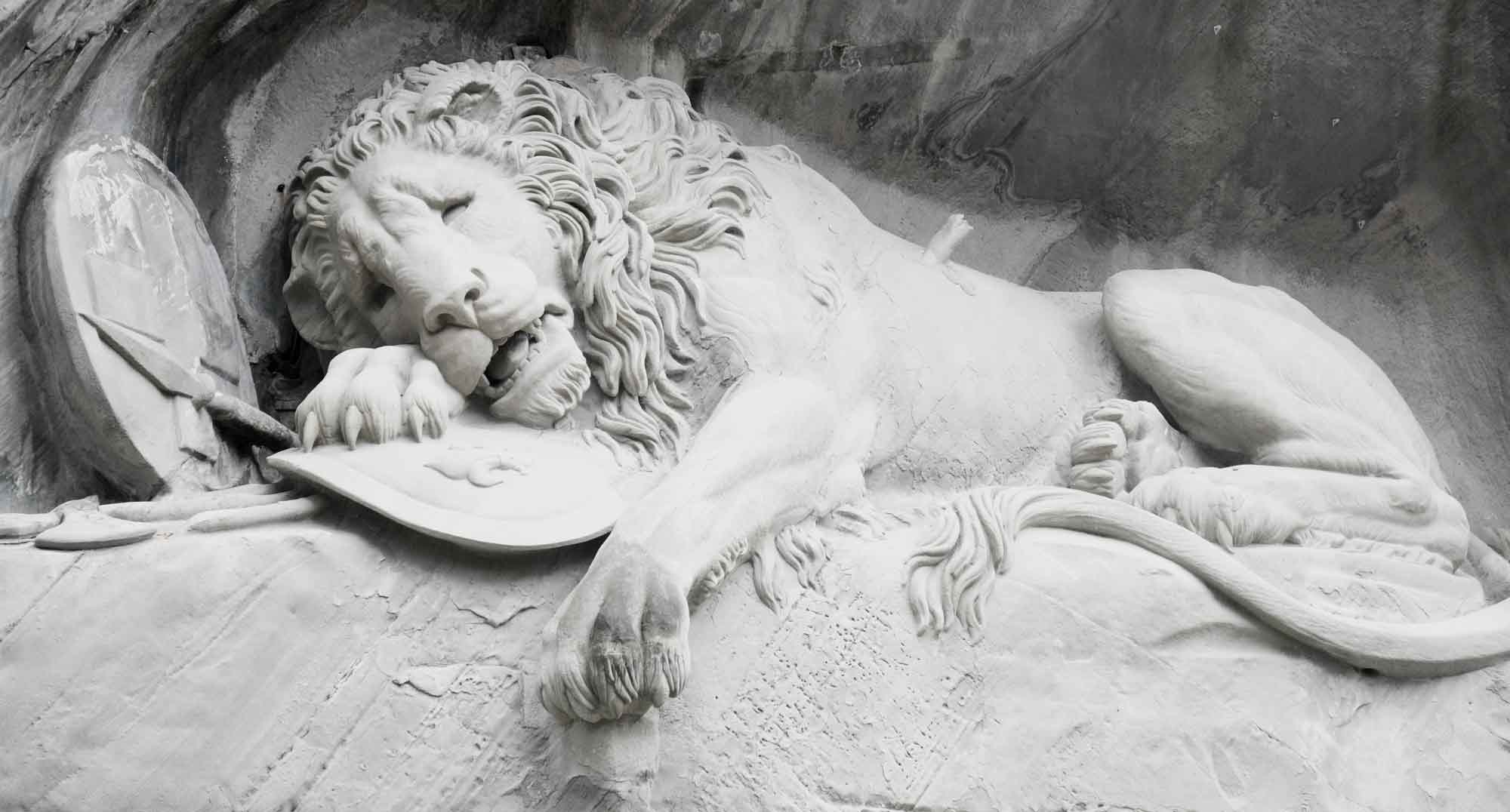REBEKAH COCHELL|GUEST
“…the Lion of Lucerne is the most mournful and moving piece of stone in the world.” —Mark Twain
Art has a transcendent quality. It can cause us to contemplate the struggles and joys of human experience. Sometimes it overwhelms us with the beauty of the mundane or the eternal. I believe that the search for truth, beauty, and goodness is inherent to the artistic process and is so embedded in the human heart that even if artists do not acknowledge the Creator in their hearts, their art often communicates some truth of the Divine.
Since moving to Europe, I have encountered powerful aesthetic responses to beauty three times, bringing me close to tears, and taking my breath away. One of these times was when I visited the Lion of Lucerne in Switzerland.
A Monument to Sacrifice
Walking into the tranquil garden, I was not prepared for the beauty of the sculpture, nor for its immense size. As I stared into the mournful face of the massive lion a few meters above me, I was convinced that I was peering into the dying face of Aslan on the stone table. (Apologies to those who have not discovered C. S. Lewis’ Narnia books yet.)
The Lion of Lucerne rests in a garden in Lucerne, Switzerland, carved into a huge sandstone that was once a quarry. A pond lies below the cave where the lion rests. Photos and words cannot explain how grand, how beautiful, nor how anguished this lion is. The lion measures 10 meters wide and 6 meters high (roughly 30 feet by 18 feet) and is set a few meters above the pond.
The lion is in the “throes of death,” yet his body evokes peace, as he leans on his right front leg. Protruding from his left back is a broken spear, the evident cause of his imminent death. His head rests on his huge right front paw. A shield with a fleur-de-lis, the emblem of the French monarchy, serves as his pillow. Under the shield are three more weapons. Propped against the wall behind the lion’s head is another shield with a square cross, the Swiss emblem.
The Lion of Lucerne was not meant to be Aslan. The monument was carved before C. S. Lewis wrote any Narnia story. Although Lewis surely knew about the monument.
When Art Reminds Us of the Divine
The monument commemorates the Swiss soldiers who fought in the service of the French monarchy during the French Revolution, when insurgents overtook the Tuileries Palace on August 10, 1792. While the Royalists and French guardsmen fled or joined the revolution, only the Swiss soldiers remained. They held off the revolutionaries for ten hours but eventually were massacred or sentenced to the guillotine. This was the turning point of the French Revolution. The monarchy was overthrown. The Reign of Terror followed.
As always, history is complicated. Whether or not the side of the Swiss soldiers was right or wrong, their courage and sacrifice is commemorated by this monument. Monuments are meant to remind us that through the faulty acts of mankind, there are higher values that we should aspire to.
But why would a statue of a dying lion emotionally affect us and inspire us to higher values?
I come back to Aslan. In so many ways, this lion resembles Aslan. If you know the story, Aslan’s act of self-sacrifice broke the “ancient magic,” as Lewis calls it, and saved a young boy’s life as a result. Aslan’s death was an allegory of the sacrifice of Christ, who broke the ancient curse of sin and death that held humanity captive.
Art Creates Apologetic Opportunities
Ironically, we live in a society that praises self-love and self-preservation, yet self-sacrifice is a universally admired action. Consider the movies that resonate with viewers and how this rings true. The hero who gives his life, knowing it will save others is a constant theme in the most beloved and popular movies. And it’s not only a theme, but always the pivotal moment. Whether it is Iron Man’s willingness to die to save the entire world in “Avengers: End Game” or when Harry Potter’s mother gives her life to protect her infant son, these actions are the ones that make the story meaningful. Likewise, the most inspiring news stories are ones where men and women risk their lives to save others, whether during natural catastrophes or dangerous situations. A powerful example is when two teachers in Uvalde, Texas died protecting their students during the recent school shooting.
And that is why The Lion of Lucerne is a powerful piece of art. While memorializing the sacrifice of the Swiss soldiers, the Lion points to the nobility of those who give their lives for others, ultimately pointing to Christ’s sacrifice on the cross. Surely, we as Christians, can look at this example and be reminded that despite the lies of our society and culture, there are universal truths that everyone recognizes in their hearts. Examples in art, literature and movies can help us start conversations with our neighbors and friends. They can help us point out how relativism doesn’t explain the truths we know in our hearts, nor the longing we have for the eternal which can only be satisfied in Christ.
“…he has put eternity into man’s heart” (Ecc. 3:11).
*Image courtesy of Rebekah Cochell

Rebekah Cochell
Rebekah is a graduate of Liberty University (MFA: School of Digital and Studio Art: Graphic Design). She is an adjunct professor for Liberty University’s Online School of Communication and the Arts. Currently living in Germany, she is married to James, an Army Chaplain and teaching elder of the PCA. They have three grown children, Ransom, Ethan, and Rose. Rebekah integrates art activities in both the Bible studies she teaches and the chaplain training events that she co-teaches with her husband. She enjoys traveling, photography, painting, and reading the classics.

